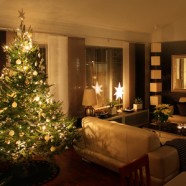
The holiday season sees a higher electrical usage in residential properties than almost any other time in the year. With lights and other decorations being added indoors and out, additional appliances being used to prepare holiday meals, and multiple new gifts being plugged in at the same time, homeowners need to be extra vigilant to keep safety in mind. Not only is higher residential electrical usage a source of higher utility bills, it’s also the source of accidents and fire damage that’s not often seen any other time of the year. Common sense and preparation are key to electrical safety during the holidays.
Cords
Most people reuse strings of lights and other holiday decorations over and over each year. While most decorations are meant to last for years, it’s crucial to inspect each one before using it. Cords can snap or wear, especially if stored in extreme temperatures, and fraying wires are a certain fire hazard. Once you’ve determined that all your cords are in good condition, take care when stringing them over your house of property. Make sure none of the cords are pinched underneath or behind heavy furniture or hidden under rugs where they can be stepped on and damaged, and always use tape to secure cords in place, never nails or staples.
Lights
Strings of lights may be the most common of all holiday decorations, but they can also be the largest source of power usage and fire hazards. When decorating your outside property with light strings, always plug the lights into a GFCI outlet to protect your property from damage due to electricity coming in contact with moisture. Never connect more than three strings of lights together, and wrap all connections with plastic wrap to keep snow and ice away. Drape lights over bushes carefully, making sure branches don’t come in contact with light bulbs. Consider replacing your old traditional strings of lights with the newer LED lights. LED holiday lights have a wide range of advantages:
- LED lights are brighter than traditional bulbs
- They come in a large variety of attractive colors
- They use much less power, making them less expensive to use
- LED light bulbs are cool to the touch when in use, reducing the danger of fire damage
Always use a wooden or fiberglass ladder when hanging holiday lights, and always turn off all lights before leaving home or going to bed.
Cooking
The holidays often mean parties and family dinners, and this calls for cooking larger amounts of food than during the rest of the year. Many people have small appliances, such as deep fryers, slow cookers, stand mixers, and blenders that only get used once a year. This additional usage can cut down on counter space, which can turn your kitchen into an electrical danger zone. Always plug appliances into an approved GFCI outlet. Do not string cords through dishwater or puddles, and keep them away from other appliances. Use one appliance at a time, or at least one per cooking area. Inspect each appliance, including the plug and cord, before using it, and unplug each one as soon as it’s no longer in use.
Other Tips
Keep residential electrical safety in mind throughout the holiday season while enjoying the time with friends and family. During cold winter days, keep electrical space heaters away from rugs, curtains, gifts, and holiday decorations. Test your smoke alarm and replace the batteries if needed. Avoid overloading electrical outlets with too many plugs; instead, use a power strip with a circuit breaker built in. Keep all electric cords out of reach of small children and chewing pets, and only allow responsible adults to plug in new toys and gifts for children to play with.

Recent Comments